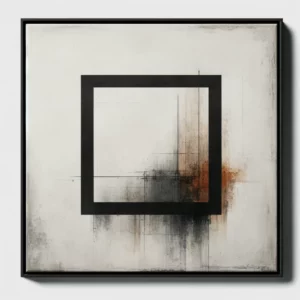Minimalism in abstract art represents a powerful response to the complexity and chaos of modern life, advocating for simplicity and clarity through the reduction of forms, colors, and materials. This artistic movement emerged in the late 1950s and gained momentum in the 1960s as a significant departure from the expressive and emotive styles that dominated the art world at the time. Minimalist artists sought to strip their works down to their essentials, emphasizing the purity of the medium itself. In this context, the phrase “less is more” encapsulates the philosophy behind minimalism, where the focus lies not on what is included, but rather on what is omitted.
Embracing Simplicity in Abstract Art
The essence of minimalism in abstract art lies in the artist’s desire to express profound concepts through simple visual means. The movement challenges viewers to reconsider their perceptions of art and to engage with it on a deeper level. By eliminating unnecessary details and distractions, minimalism encourages a direct and intimate experience between the artwork and its audience. This approach often results in a meditative quality that invites contemplation and reflection.
Minimalist artists utilize various techniques to achieve their goals. Here are some key characteristics that define their works :
- Limited Color Palette: the use of a few carefully chosen colors creates a striking impact without overwhelming the viewer.
- Geometric Shapes: simple forms, such as squares, rectangles, and lines, are commonly employed to convey structure and balance.
- Emphasis on Space: negative space plays a vital role in minimalist art, allowing for a more profound understanding of composition and form.
- Repetition: repeating elements fosters a sense of rhythm and unity, further enhancing the overall experience of the piece.
- Materiality: the choice of materials often reflects the artist’s intention to highlight the inherent qualities of the medium, whether it be canvas, metal, or wood.
Minimalism strips away the ornate and the elaborate, inviting viewers to engage with the fundamental aspects of art. The reduction of elements not only serves aesthetic purposes but also conveys deeper philosophical messages about existence and perception.

The Influential Artists of the Minimalist Movement
Several artists have played pivotal roles in the development and recognition of minimalism as a distinct art movement. Their contributions helped shape the trajectory of modern art and inspired future generations. Donald Judd, Agnes Martin, and Frank Stella are among the most notable figures in this movement.
Donald Judd’s work exemplifies the minimalist ethos with its emphasis on form and material. His iconic boxes, often fabricated from industrial materials, challenge traditional notions of painting and sculpture. By presenting his works as three-dimensional objects, Judd blurs the boundaries between art and architecture, prompting viewers to consider the relationship between space and form.
Agnes Martin, on the other hand, brought a more introspective approach to minimalism. Her delicate, grid-like paintings convey a sense of tranquility and meditation. Martin’s use of soft colors and subtle variations in line highlights her commitment to simplicity while inviting viewers to explore the emotional resonance within her works.
Frank Stella is known for his innovative use of shape and color, pushing the limits of minimalism while still adhering to its core principles. His work often incorporates bold geometric patterns and vibrant hues, challenging the viewer’s perception of depth and form. Stella’s dynamic compositions showcase the potential for minimalism to encompass a broad range of expressions.
The Philosophy Behind Minimalism
The philosophical underpinnings of minimalism extend beyond the visual realm, touching upon themes of existentialism and the search for meaning in an increasingly complex world. Minimalism can be seen as a reaction against consumerism and excess, promoting a lifestyle that values simplicity and authenticity. Artists often engage with these themes, using their work to provoke thought and encourage a more profound understanding of existence.
Minimalism also challenges the traditional hierarchy of art forms, emphasizing that even the most straightforward expression can carry significant weight. The focus on process and intention rather than mere aesthetic appeal invites a broader dialogue about what constitutes art in contemporary society. This approach resonates with many, as it mirrors a growing desire for clarity and authenticity in an era marked by noise and distraction.
The Enduring Legacy of Minimalism in Abstract Art
The influence of minimalism in abstract art continues to reverberate through contemporary artistic practices. Today, many artists draw inspiration from minimalist principles, integrating them into various mediums and styles. The movement’s emphasis on simplicity resonates with current cultural trends that prioritize mindfulness and intentionality.
As society grapples with the complexities of modern life, the minimalist philosophy offers a pathway toward greater awareness and appreciation of the fundamental aspects of existence. The legacy of minimalism remains relevant, encouraging both artists and viewers to explore the depths of their perceptions and to embrace the beauty found in simplicity.
In the realm of abstract art, minimalism serves as a profound reminder that sometimes, less truly is more. This enduring movement invites all to appreciate the essential qualities of art, challenging them to find meaning in the simplest forms and colors.
